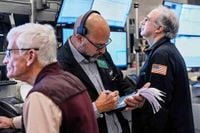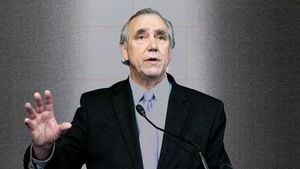As the final week of October 2025 draws to a close, global financial markets are sending mixed signals, reflecting a world in flux. From the bustling trading floors of New York to the energetic bourses of Karachi and the high-stakes world of semiconductor giants, investors are riding a wave of optimism, caution, and rapid technological transformation.
On Thursday, October 23, U.S. stocks surged to the edge of their all-time highs, buoyed by a combination of robust corporate earnings and geopolitical developments. According to the Associated Press, the S&P 500 rose by 0.6%, coming within a hair’s breadth of its record set earlier in the month. The Dow Jones Industrial Average increased by 0.3%, while the tech-heavy Nasdaq composite jumped 0.9%. The gains were led by oil and gas stocks, which soared after President Donald Trump’s announcement of sweeping new sanctions on Russia’s crude oil sector, targeting industry giants Rosneft and Lukoil. The move, aimed at pressuring Russian President Vladimir Putin over the ongoing war in Ukraine, sent oil prices up more than 5% in a single day.
Exxon Mobil, ConocoPhillips, and Diamondback Energy all posted notable gains—1.5%, 3%, and 4% respectively—on the back of this oil rally. The jump helped oil prices recover from recent losses, although, as AP notes, crude remains down over 10% for the year. The market’s upward momentum was further fueled by strong earnings from major corporations. Dow’s stock leaped 12.5% and Las Vegas Sands rallied 13.6%, both beating Wall Street’s expectations. Tesla, too, managed a 1.1% climb despite reporting a weaker profit; its revenue, however, came in stronger than anticipated.
Yet not every sector was basking in the glow. Molina Healthcare’s shares plummeted 17.9% after its quarterly profit missed analyst targets, with CEO Joseph Zubretsky pointing to “a challenging environment for medical costs.” IBM, despite posting better-than-expected profit and revenue, saw its stock dip 1.7% because of underwhelming results from its Red Hat unit.
Meanwhile, gold prices, which had been on a tear throughout 2025, rebounded 2% to $4,145.60 per ounce after a sharp two-day slide. The price of gold is up an astonishing 57% for the year, a reflection of investor anxiety over mounting government debt and persistent inflation fears. The U.S. government’s gross national debt surpassed $38 trillion on October 22, sparking fresh concerns about the long-term impact on inflation and economic stability.
In the bond market, the yield on the 10-year Treasury note edged up to 3.99% ahead of a delayed inflation report, which investors hope will offer clues about the Federal Reserve’s next move on interest rates. The Fed had cut rates for the first time this year just last month, but officials remain wary of stoking inflation further.
The picture was different just a day earlier. On October 22, Wall Street saw a reversal of fortunes, with the S&P 500 dropping 0.5%, the Dow falling 334 points (0.7%), and the Nasdaq down 0.9%. The slide was driven partly by disappointing earnings from Netflix, whose shares tumbled 10.1% after a weaker-than-expected profit report. AT&T and Texas Instruments also posted losses, while Intuitive Surgical and Boston Scientific provided rare bright spots, surging 13.9% and 4% respectively after beating profit forecasts.
Investors have been grappling with the question: can companies continue to justify lofty valuations after the S&P 500’s 35% rally since April? The answer, it seems, depends on sector and sentiment. As AP reported, the pressure is on for firms to deliver solid growth, lest they face harsh market corrections.
Across the globe, the mood was equally varied. European markets generally posted gains, while Asian indexes were mixed. Hong Kong’s Hang Seng rose 0.7% and Shanghai’s composite edged up 0.2% after the conclusion of a significant Communist Party meeting in Beijing, where leaders pledged to accelerate self-reliance in science and technology. In contrast, Japan’s Nikkei 225 fell 1.4% and South Korea’s Kospi slipped 1% on October 23, underscoring the region’s volatility.
Turning to South Asia, the Pakistan Stock Exchange (PSX) faced a tough end to the week. As Dunya News reported, the KSE-100 index dropped 1,100.4 points to close at 163,490.37 on October 24, marking a 0.67% decline as investors booked profits ahead of the weekend. The day before, the market had already shed nearly 2,000 points. Of the 474 companies trading, 291 posted losses against 147 gainers, with trading volumes and market capitalization both sliding. The total traded value fell to Rs49.52 billion, down from Rs55.06 billion, and market capitalization dipped to Rs18.99 trillion.
Back in the U.S., the technology sector is undergoing its own transformation, with Intel Corporation emerging as a symbol of the broader industry’s pivot toward artificial intelligence. On October 24, Intel reported $13.7 billion in Q3 revenue—a 3% year-over-year increase—and $4.1 billion in GAAP earnings, reversing losses from the previous year. Non-GAAP earnings per share came in at $0.23, beating Wall Street’s expectations. The company’s Client Computing Group saw revenue rise 5% to $8.5 billion, while its Data Center & AI unit dipped 1% to $4.1 billion. The Foundry business, which reported $4.2 billion in revenue (down 2%), remains a work in progress but is central to Intel’s future ambitions.
Intel’s resurgence is being driven by surging demand for AI-capable chips. The company is integrating its traditional CPUs with AI accelerators and custom ASICs, expanding its foundry services, and ramping up U.S.-based manufacturing—most notably with Fab 52 in Arizona now fully operational. A new partnership with NVIDIA to develop custom data-center and PC products underscores Intel’s commitment to becoming a central player in the AI ecosystem. Investors responded enthusiastically, sending Intel’s shares up as much as 8% at one point after the earnings release.
However, Intel faces formidable competition from the likes of TSMC, NVIDIA, and AMD, and its foundry division continues to operate at a loss. The company’s outlook for Q4 is cautious: projected revenue between $12.8 billion and $13.8 billion, with non-GAAP EPS around $0.08. Still, as Meyka AI PTY LTD notes, Intel’s momentum signals a broader shift in the U.S. chip industry, bolstered by government support such as the CHIPS Act.
All told, the final week of October 2025 highlights a world of contrasts: U.S. markets on the verge of new highs, Asian markets mixed, Pakistan’s exchange under pressure, and the semiconductor sector on the cusp of a new AI-driven era. For investors and observers alike, the message is clear—adaptability and vigilance are the watchwords as the global financial landscape evolves at breakneck speed.






